Open Access Library Journal
2018, Volume 5, e4487
ISSN Online: 2333-9721
ISSN Print: 2333-9705
Application of PSCF and CWT to Identify
Potential Sources of Aerosol Optical Depth in
ICIPE Mbita
Misiani Zachary1,2*, Lun Yin3, Mwai Zacharia1,2
1School of Atmospheric Sciences, Nanjing University of Information Science and Technology, Nanjing, China
2Kenya Meteorological Department, Ministry of Environment & Forestry, Nairobi, Kenya
3Yunnan Academy of Social Sciences, Kunming, China
How to cite this paper: Zachary, M., Yin,
L. and Zacharia, M. (2018) Application of
PSCF and CWT to Identify Potential Sources
of Aerosol Optical Depth in ICIPE Mbita.
Open Access Library Journal, 5: e4487.
https://doi.org/10.4236/oalib.1104487
Received: March 9, 2018
Accepted: April 17, 2018
Published: April 20, 2018
Copyright © 2018 by authors and Open
Access Library Inc.
This work is licensed under the Creative
Commons Attribution International
License (CC BY 4.0).
http://creativecommons.org/licenses/by/4.0/
Open Access
Abstract
This paper evaluates the effects of long-range transport patterns of air trajec-
tories arriving at a rural ground based station, ICIPE Mbita 1125 meters above
mean sea level. Mass concentration data of fine mode AOD, coarse mode
AOD and fine mode fraction AOD were combined with back-trajectory clus-
ter analysis. The Potential Source Contribution Function (PSCF) model and
Concentration-Weighted Trajectory (CWT) method were used to evaluate the
transport pathways and Potential Source Areas (PSA) affecting AOD loadings
in western parts of Kenya during wet (MAM) and dry (JJA) seasons. The main
sources and paths of advection to source and receptor regions and its relation
to AOD concentration were identified. Using these methods, the Geographic
Information System (GIS) based software and MeteoInfo was used for query
and computation of potential source contribution function and concentration
weighted trajectory analyses when the measurement data were included. The
results for both PSCF and CPF were sufficient indicators that pollutants ori-
ginated from two main sources, that is, northeastern and southeast directions
from the site.
Subject Areas
Environmental Sciences
Keywords
GIS, MeteoInfo, PSCF, CWT, PSA, MAM and JJA
DOI: 10.4236/oalib.1104487 Apr. 20, 2018
1
Open Access Library Journal
�
M. Zachary et al.
1. Introduction
The atmospheric aerosols usually occur in a bimodal distribution. The smaller
part of these particles is referred to as the fine mode aerosols. They have a radii
ranging between 0.1 to 0.25 µm, while the larger particles comprise of coarse
mode aerosols. The larger particles generally have radii ranging between 1.0 to
2.5 µm, lastly, fine mode fraction aerosols which can be defined as the propor-
tion of fine mode aerosols to the total. This is an optical measurement of the
proportion by volume [1], [2].
The concentrations of atmospheric fine mode, coarse mode and fine mode
fraction Aerosol Optical Depth (AOD) pollutants in western parts of Kenya are
mainly affected by both local and regional source emissions. Statistical me-
thods such as trajectory clustering and Potential Source Contribution Function
(PSCF) for analyzing air-mass trajectories have been used to gain insights into
the potential source areas (PSA) and prevail transport pathways for airborne
particles and gases [3]. Trajectory clustering which is a multivariate statistical
approach has been used as a tool for assigning trajectories into representative
groups. [4] was the first to exploit trajectory coordinates as clustering va-
riables, and various other clustering algorithms have been used in more recent
studies [5].
PSCF method tends to give a good angular resolution but poor radial resolu-
tion because the trajectories converge as they approach the receptor. The con-
centration field method developed by [6] calculates the mean or geometric mean
concentration of each grid cell which is then weighted by the residence time. [2]
refined this method by redistributing the concentration fields, and [7] further
refined it to a Concentration-Weighted Trajectory (CWT) method. The current
paper uses AOD trajectories analysis data for wet and dry seasons from 2013 to
2015 to identify the potential source contribution function and concentra-
tion-weighted trajectory to examine and locate the main sources of air pollutants
in the study area.
2. Material and Methods
2.1. Area of Study
The study AERONET ground station is located Longitude 34.2˚E, −0.417˚S,
and 1125 meters above sea level, the red marked triangle shown in Figure
1.
2.2. Data for the Study
The Fine Mode, Coarse Mode Aerosol Optical Depth (AOD), and Fine Mode
Fraction AOD concentrations for ICIPE Mbita for wet and dry seasons for 2013,
2014 and 2015 were downloaded from AERONET Aerosol Robotic Network for
level 2.0 daily averages, available at
https://aeronet.gsfc.nasa.gov/new_web/index.html.
2
Open Access Library Journal
DOI: 10.4236/oalib.1104487
�
M. Zachary et al.
Figure 1. Map of the study area. The location marked with red triangle correspond to the
ICIPE Mbita station. The areas shaded blue represent Lake Victoria surrounded by three
countries; Kenya, Uganda and Tanzania.This map was produced on 5th March 2018 by
Misiani Zachary.
3. The Methods Used in the Analysis
3.1. Trajectory Clustering
In this study, Ward’s hierarchical method was used to form the trajectory clus-
ters for the wet and dry seasons combined, and this was based on calculating the
mean angle between all pairs of trajectories. Angular distance was chosen in
place of Euclidean distance mainly because the aim of this research work was to
use the trajectories to determine the direction from which the air masses that
reached the site had originated.
d
12
=
1
n
n
∑
i
1
−
1
−
cos
(
0.5
A B C
i
i
+
−
i
A B
i
i
(1)
where
iA
=
(
(
( )
X i
1
−
X
0
( )
X i
2
−
X
0
( )
X i
2
−
( )
X i
1
2
2
2
)
)
)
+
+
+
(
(
(
( )
Y i
1
−
( )
Y i
2
−
( )
Y i
2
−
2
2
Y
0
)
)
( )
Y i
1
Y
0
)
2
iB
iC
=
=
(
The variables X0 and Y0 define the position of the study site. Note that d12 va-
ries between 0 and π. The two extreme values occur when two trajectories are in
the same and opposite direction, respectively. More details of the angle distance
method are presented in [8].
The major transport pathways leading to the elevated AOD concentrations for
ICIPE Mbita AERONET station during wet and dry seasons could be obtained
3
Open Access Library Journal
DOI: 10.4236/oalib.1104487
�
M. Zachary et al.
by combining the trajectory with the daily fine mode, coarse mode and fine
mode fraction concentration data (Figure 2).
In order to get faster details on how the aerosols are spatially distributed from
the source point to the sinking site, 0.5˚ by 0.5˚ grid dimension was used for the
analysis of PSCF. For more detailed information and faster analysis of the AOD,
the 1˚ by 1˚ grid dimension was used for the WCT.
3.2. Potential Source Contribution Function (PSCF).
PSCF values are calculated to identify the source areas by analyzing trajectory
transport pathways [9], [10]. To analyze possible long-range sources contribut-
ing to mean daily fine mode AOD, coarse mode AOD, and fine mode fraction
AOD concentrations observed on this study area, a single grid cell was calculated
by counting each trajectory segment endpoints that terminated within that grid
cell. The number of endpoints that fall in ijth cell at a time was marked as xij,
while the total number of endpoints that fall in the same grid cell was denoted as
yij [4]. So the PSCF can be defined as
PSCF
ij
(2)
y
ij
=
x
ij
Thus, the PSCF values can be interpreted as a conditional probability de-
scribing the potential contributions of a grid cell to the high AOD loadings at
ICIPE Mbita AERONET station. In this study, the criterion value was set to
the mean concentration of all the AOD data. The study domain extends from
28˚E to 50˚E and from 15˚S to 10˚N, thus composing 2200 cells 0.5˚ by 0.5˚ in
latitude and longitude. To remove the uncertainty in cells with small values of
yij, the PSCF values were multiplied by an arbitrary weight function Wij to bet-
ter reflect the uncertainty in the values for these cells [3], [4], [11], [12]. The
weighting function reduced the PSCF values when the total number of the end-
points in a particular cell was less than about three times the average value of the
end points for each cell.
(a) (b)
Figure 2. (a) Is grid points for PSCF 0.5˚ by 0.5˚ while (b) Is grid points for calculating
CWT 1˚ by 1˚.
4
Open Access Library Journal
DOI: 10.4236/oalib.1104487
�
M. Zachary et al.
(3)
W
ij
80
1.00,
20
0.7,
<
=
0.42, 10
<
n
0.05,
ij
n
≤
ij
n
≤
ij
n
≤
ij
10
≤
80
20
3.3. Concentration-Weighted Trajectory (CWT) Method.
In order to avoid the laminations of the PSCF method whereby some grid cells
could have the same PSCF value when sample concentrations could either be
slightly higher or much higher than the criterion required as a result, it could be
much more difficult to distinguish moderate sources from strong ones. Hence
CWT method [8], [10], [13] was used with the aiming of producing a geograph-
ical overview of emission source areas within the study region.
C
ij
=
M
1
∑
M
τ =
l
1
ijl
l
1
=
∑
cτ
l
ijl
(4)
where C is the average weighted concentration in the ijth cell, l is the index of the
trajectory, M is the total number of trajectories, is the concentration observed on
arrival of trajectory l, and is the time spent in the ijth cell by trajectory l. A high
value for implies that air parcels traveling over the ijth cell would be, on average,
associated with high concentrations at the receptor. The arbitrary weighting
function described above was also used in the CWT analyses to reduce the effect
of the small values of nij. For the CWT, study domain extends from 28˚E to 50˚E
and from 15˚S to 10˚N, thus composing 550 cells 1˚ by 1˚ in latitude and longi-
tude.
4. Results and Discussion
In this present work, we have classified the data in terms of two major seasons,
namely, wet (March-May) and dry (July-August) seasons which is based on
synoptic winds and different meteorological conditions prevailing over Kenya.
Regional Contributions
Air mass residence time was analyzed by PSCF and CWT model, along with av-
erage daily concentrations of all the available fine mode AOD, coarse mode
AOD and fine mode fractions, in order to isolate regional sources of particulate
air pollution affecting the neighboring Kisumu city. The produced PSCF and
CWT values were plotted on surface maps, presented in various figures below
for both wet and dry seasons respectively.
Figure 3 shows the map for ICIPE Mbita AERONET Fine Mode AOD, Coarse
Mode AOD and Fine Mode Fraction in MAM and JJA, 2013, 2014 and 2015 us-
ing PSCF method. The colors represent the contribution levels of PSA and the
red color could be associated with high concentrations while the blue color
represents low pollutants concentrations.
The map showing the results of the PSCF analysis Figure 3 and it could be
5
Open Access Library Journal
DOI: 10.4236/oalib.1104487
�
M. Zachary et al.
Figure 3. Potential source contribution function maps of Fine Mode AOD, Coarse Mode AOD and Fine Mode Fraction in MAM
& JJA seasons during 2013. Darker colors indicate greater potential source.
seen during wet period high WPSCF values were originating from the Northern
Hemisphere [14] were found in Isiolo in eastern province, Wajir and Garissa in
north eastern province and Samburu, Baringo, Laikipia and West Pokot of Rift
valley province of Kenya. In JJA (dry season) the highest WPSCF values origi-
nates from the Southern Hemisphere were found in Makueni, Machakos and
Kitui in eastern province , Kajiado in Rift valley, Nairobi and TaitaTaveta and
Kwale in Coastal provinces of Kenya.
The results for fine mode AOD, coarse mode AOD and fine mode fraction
concentrations identified by CWT method in Figure 4 were very similar to the
results analyzed by PSCF method in Figure 3. The regions with red color, were
corresponding to the main contributor sources associated with the highest AOD
values. During this wet season, the highest WCWT values covering the map
were distributed in central parts of Kenya including areas of Nairobi all the way
through Rift valley to western province for coarse mode AOD. The fine mode
AOD concentration is lower than coarse mode though for the fine mode fraction
AOD its spatial coverage is on a wider spatial coverage than the fine mode and
coarse mode AOD. These areas were the main contribution sources associated
with the highest AOD concentrations.
In JJA (dry season), the high WCWT values were mainly located along all the
counties bordering Kenya and Tanzania from Lake Victoria up to Indian Ocean.
This demonstrated that the contribution from long-range transport and sources
outside of ICIPE Mbita were significant for all of the above AOD.
In year 2014, the PSCF and CWT analyses from Figure 5 and Figure 6 gave
6
Open Access Library Journal
DOI: 10.4236/oalib.1104487
�
M. Zachary et al.
Figure 4. Concentration-weighted trajectory method analysis maps of ICIPE Mbita in MAM & JJA during 2013. Darker colors
indicate greater influence.
Figure 5. Potential source contribution function maps of Fine Mode AOD, Coarse Mode AOD and Fine Mode Fraction in MAM
& JJA seasons during 2014. Darker colors indicate greater potential source.
DOI: 10.4236/oalib.1104487
Open Access Library Journal
7
�
M. Zachary et al.
Figure 6. Concentration-weighted trajectory method analysis maps of ICIPE Mbita in MAM & JJA during 2014. Darker colors
indicate greater influence.
somewhat the same results for ICIPE Mbita. From the distribution of PSCF val-
ues Figure 5 one can see that the sources of AOD which affected Mbita during
wet season were located in the North eastern and some of the coastal and eastern
provinces of Kenya. These regions are mainly arid and semi-arid which com-
prises of Mandera, Wajir, Tana River, and Marsabit. While in JJA (dry season),
from both figures we can see that much of the aerosols are concentrated on the
southern parts of Kenya especially the border between Kenya and Tanzania. This
shows a clear indication that the most aerosols originate from the Madagascar
Island while others were locally pollinators [14].
From Figure 6, during wet season, it can be observed that most aerosols con-
certation originated from northeastern direction (Somalia land), Figure 6, fine
mode AOD was ranging from 0.03-0.1 while 6 coarse modes it ranges from
0.03-0.18 and lastly fine mode fraction the values were ranging from 0.3-0.7.
Fine mode Fraction AOD were more dominate among the other AOD. As the
season changes to dry, the direction of AOD JJA also changes, most AOD ar-
rived on the ICIPE Mbita were coming from southeast direction especially along
the border of Kenya and Tanzania. Coarse mode AOD was with the highest val-
ues.
From Figure 8, in year 2015, it can be observed from both wet and dry season,
that mostly AOD were coming from both NE and SE direction which led to an
increasing amount of AOD concertation to our areas of interest. Due to the
8
Open Access Library Journal
DOI: 10.4236/oalib.1104487
�
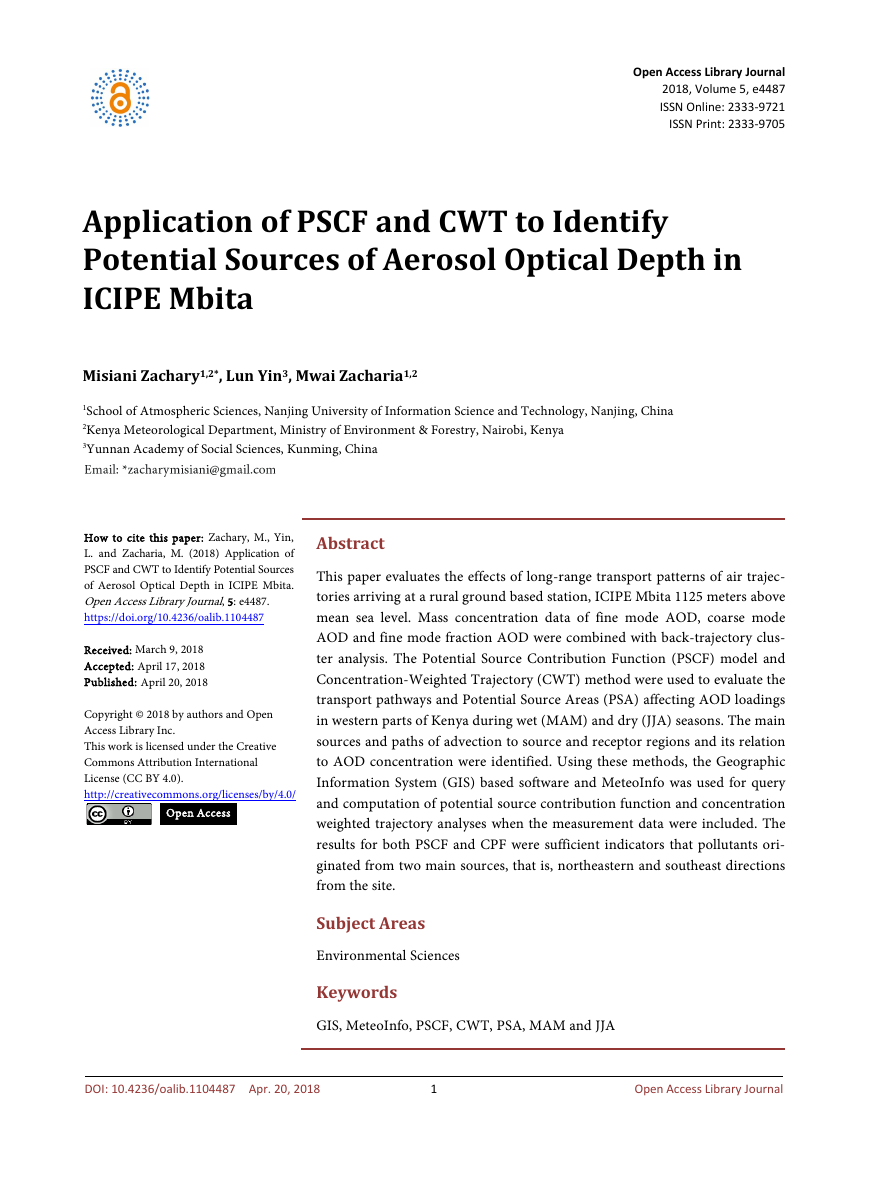
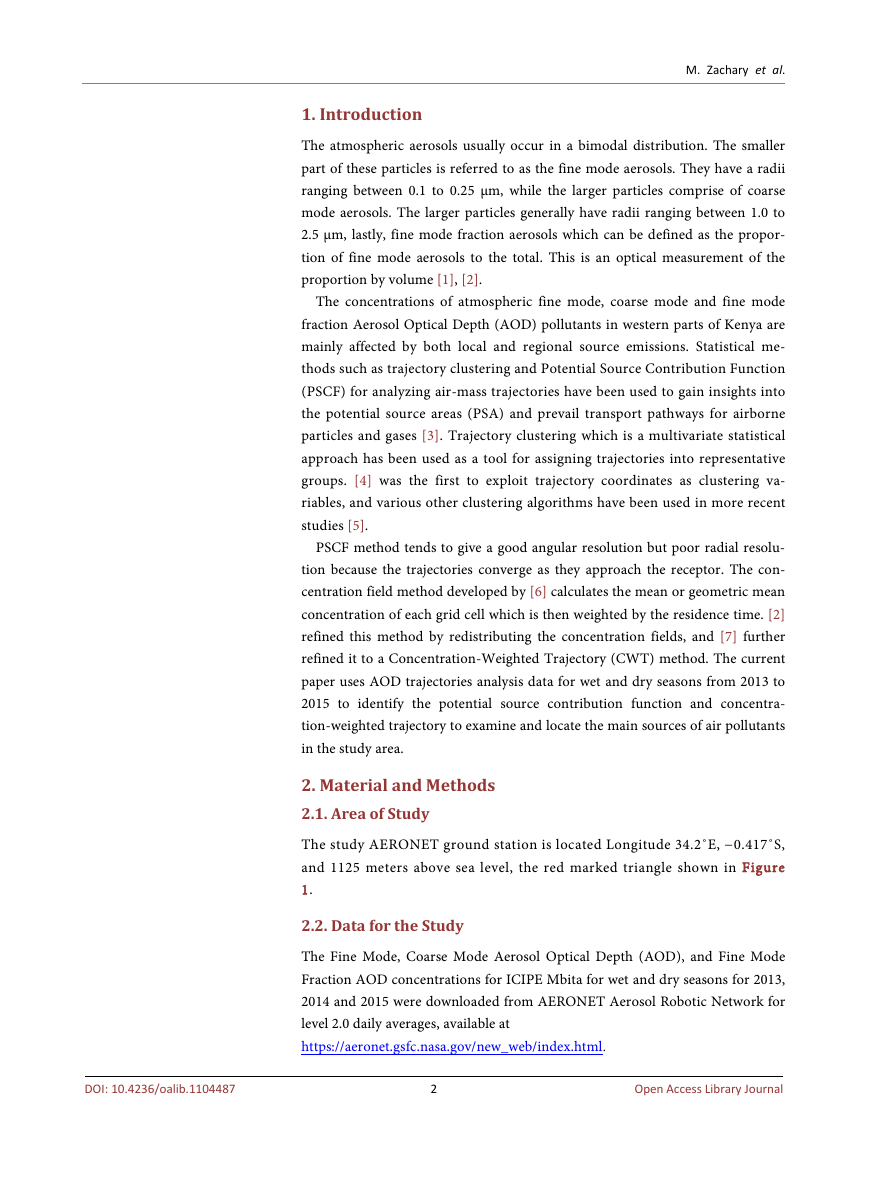
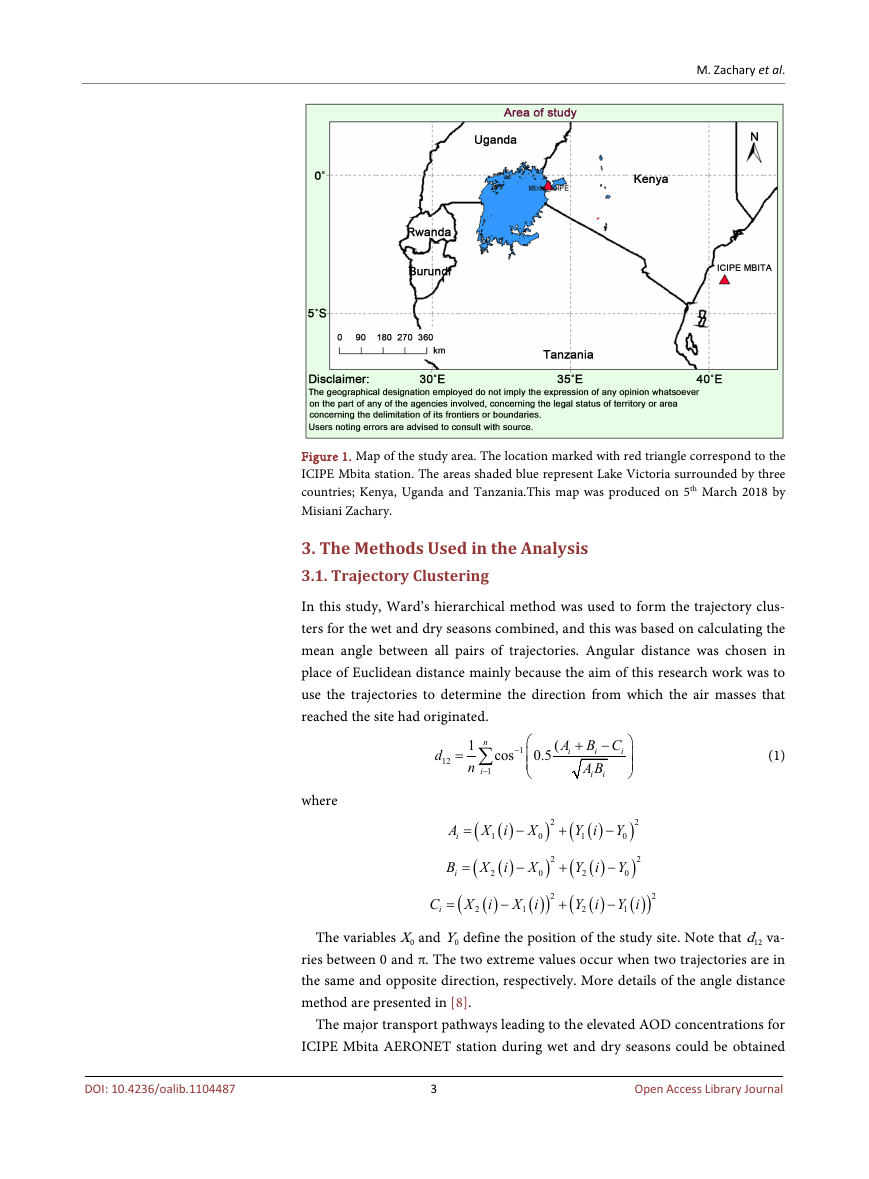

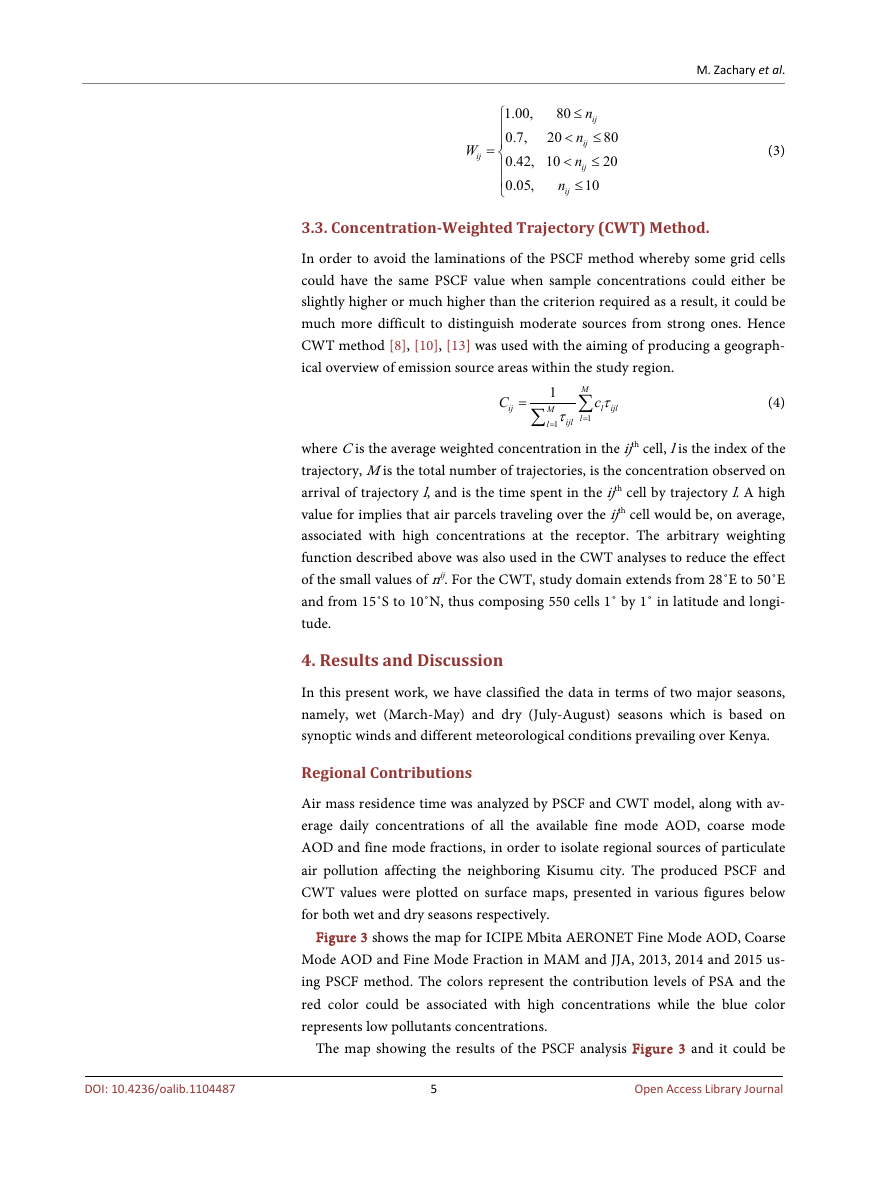
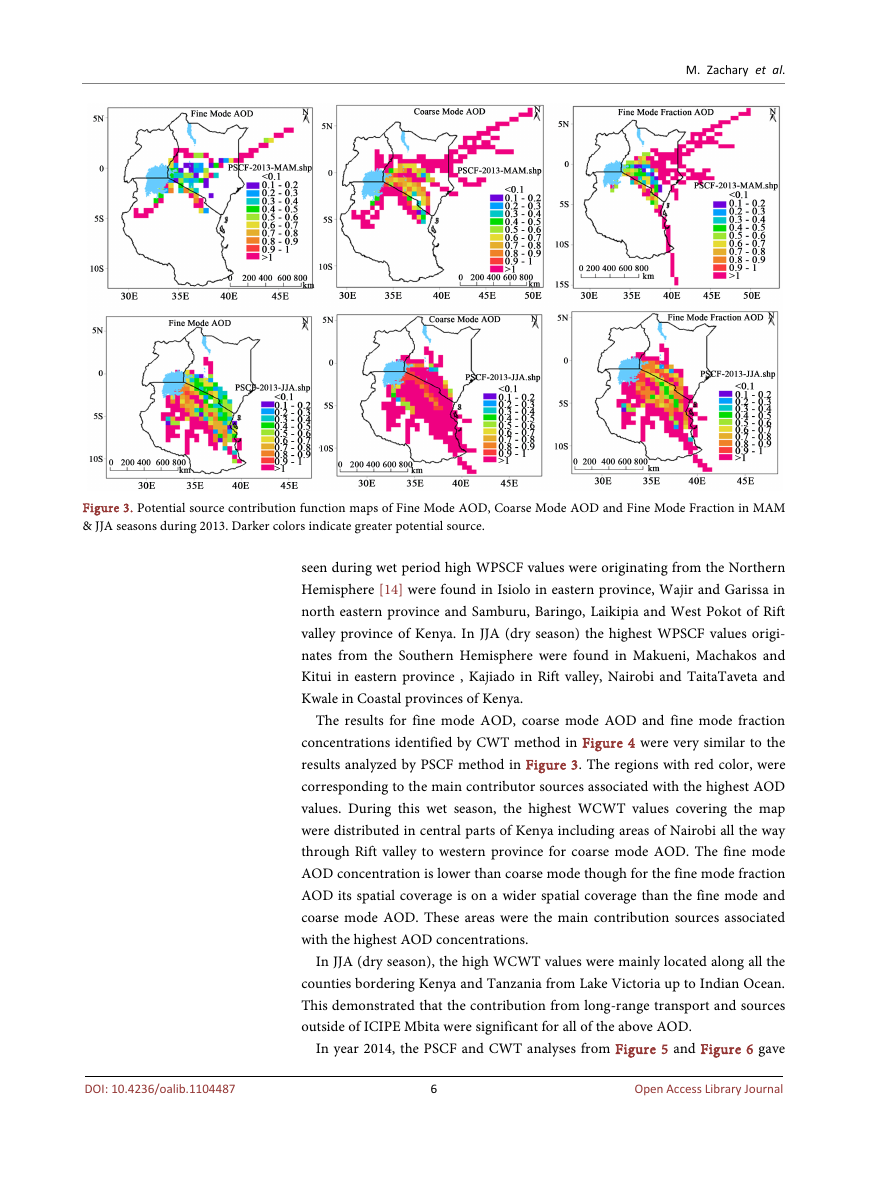
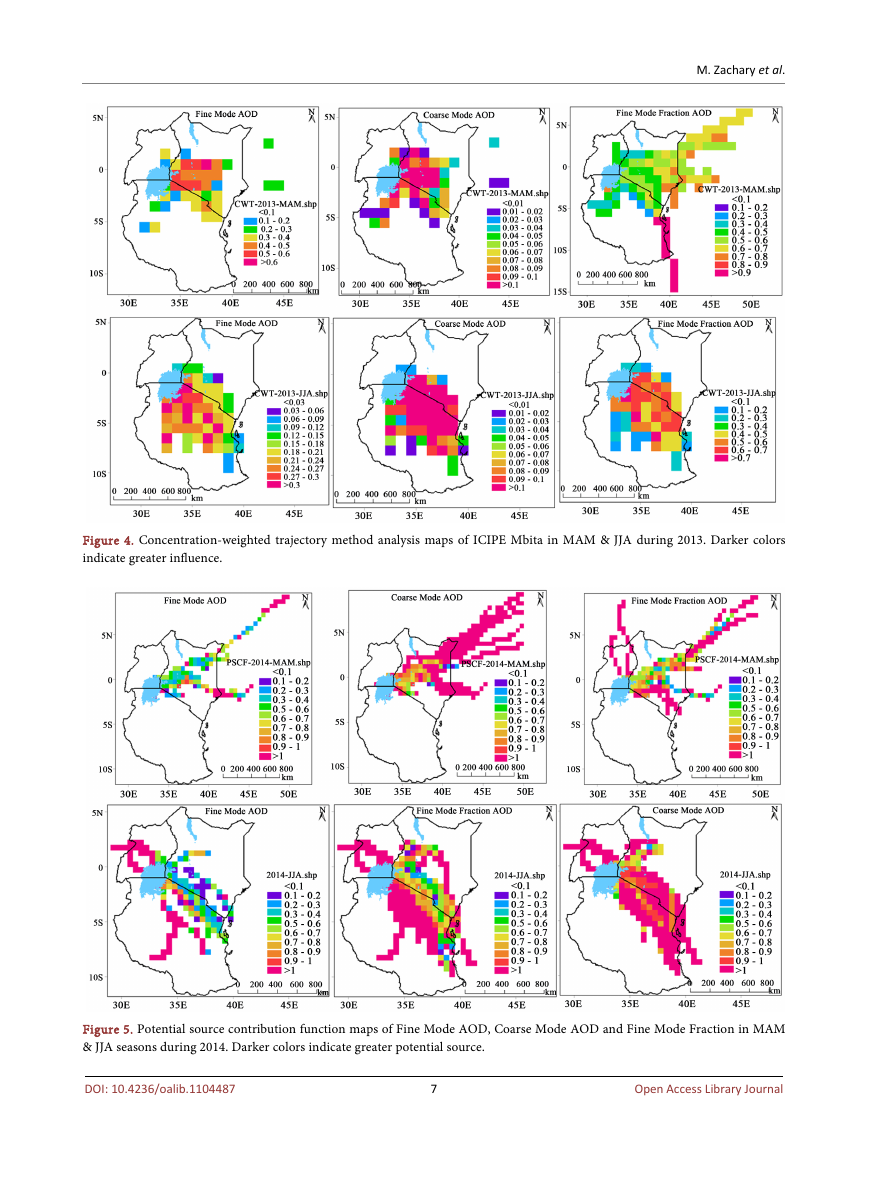
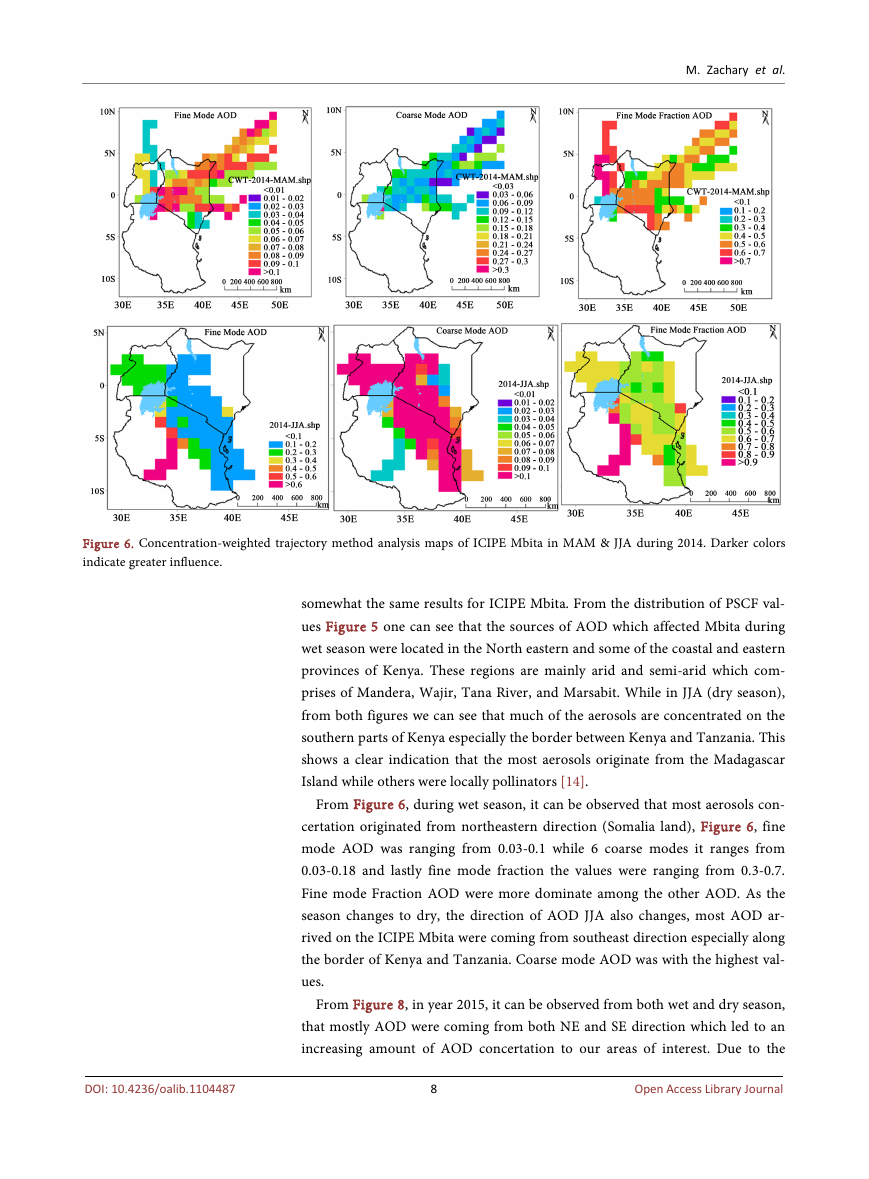








 2023年江西萍乡中考道德与法治真题及答案.doc
2023年江西萍乡中考道德与法治真题及答案.doc 2012年重庆南川中考生物真题及答案.doc
2012年重庆南川中考生物真题及答案.doc 2013年江西师范大学地理学综合及文艺理论基础考研真题.doc
2013年江西师范大学地理学综合及文艺理论基础考研真题.doc 2020年四川甘孜小升初语文真题及答案I卷.doc
2020年四川甘孜小升初语文真题及答案I卷.doc 2020年注册岩土工程师专业基础考试真题及答案.doc
2020年注册岩土工程师专业基础考试真题及答案.doc 2023-2024学年福建省厦门市九年级上学期数学月考试题及答案.doc
2023-2024学年福建省厦门市九年级上学期数学月考试题及答案.doc 2021-2022学年辽宁省沈阳市大东区九年级上学期语文期末试题及答案.doc
2021-2022学年辽宁省沈阳市大东区九年级上学期语文期末试题及答案.doc 2022-2023学年北京东城区初三第一学期物理期末试卷及答案.doc
2022-2023学年北京东城区初三第一学期物理期末试卷及答案.doc 2018上半年江西教师资格初中地理学科知识与教学能力真题及答案.doc
2018上半年江西教师资格初中地理学科知识与教学能力真题及答案.doc 2012年河北国家公务员申论考试真题及答案-省级.doc
2012年河北国家公务员申论考试真题及答案-省级.doc 2020-2021学年江苏省扬州市江都区邵樊片九年级上学期数学第一次质量检测试题及答案.doc
2020-2021学年江苏省扬州市江都区邵樊片九年级上学期数学第一次质量检测试题及答案.doc 2022下半年黑龙江教师资格证中学综合素质真题及答案.doc
2022下半年黑龙江教师资格证中学综合素质真题及答案.doc